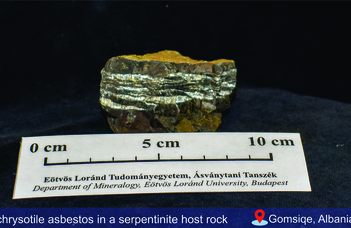
Natural occurring asbestos (NOA) and the related environmental risk in Albania
Ambra Hyskaj, 1st year PhD-student
Doctoral School of Environmental Sciences - Environmental Geosciences
Supervisor: Tamás G. Weiszburg
What is asbestos?
Asbestos is a group of natural silicate minerals with fibrous habit, known for their special thermo- mechanical characteristics (flexibility, high heat resistance, high tensile strength, high chemical and mechanical durability, low thermal and electrical conductivity). Asbestos fibers in the environment can be natural, from the rock (NOA - Naturally Occurring Asbestos) or can derive from industrial materials such as (mainly earlier produced and used) asbestos cement roofing tiles, sprayed insulations etc. NOA has been and is still causing a high-probability risk to human health, especially in the cases of disturbance (road cuts, tunnel construction) or natural environmental processes as erosion in NOA rich geological settings.
Around the world there are countries with numerous natural outcrops of NOA, such as Canada, the USA, Italy, Russia, Kazakhstan, China (earlier or recent producers of asbestos), including also Albania, my home country, whereas other countries, like Hungary, have no real NOA problem. While some developed countries have been studying the complex system of environmental interaction of natural occurrence of asbestos together with risk assessment, in Albania there is no data regarding the possible risk coming from the NOA present.
The existing outcrops in Albania have been identified in the 1960-1990s, looking for asbestos as a raw material and sometimes were also disturbed by the geological explorations. However, these localities were unfortunately left abandoned, unsecured and no information is available to the public for their location and the risk they might provide.
In the case of the richest NOA occurrences, the host environment (host rock) together with surrounding environmental factors such as soil, water and air are being identified and analyzed using a variety of analytical techniques. Beside the least harmful and (luckily) most frequent asbestos mineral, chrysotile, the more harmful tremolite amphibole asbestos and other fibrous minerals have been identified in the studied area. Fibers are detected in the source rocks, soil 2 samples and the air, too. The risk assessment and information spread is important to prevent further human exposure coming from disturbance.
How is NOA regulated?
Naturally, one cannot regulate the natural presence of a mineral in the environment. Thus, it is important that an evaluation of the risk is done. At the moment, there is no comprehensive international regulation /guideline set on the evaluation of risk from NOA. We are also focusing in pointing out the current legislative situation and issues.
It is clear that an easy-to-follow guideline system for NOA-related-risk identification is needed. Counting on the current developments in science and our team’s motivation, we sincerely feel that our study on a NOA-rich area (Albania) will contribute to fill the yet existing gap in natural environmental risk evaluation protocol, and will also help to create proper legislation background for land use and information dissemination to the wider public in NOA-rich areas.




